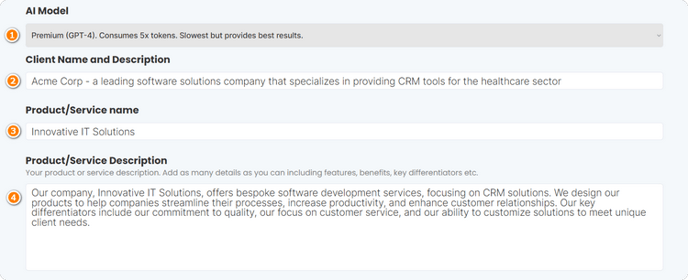Case Study
In this guide, we will walk you through the steps to get started, explore the features, and provide helpful tips
Overview
The tool is designed to structure your customer success stories into impactful case studies. It uses key details about your client, your solution, the problems it addressed, and the ensuing results to formulate a persuasive case study.
Getting Started
To access the tool, sign up for a subscription plan*. After completing the registration process, log in using your credentials.
* here is more about Pro and Free versions.
Follow these steps to use the tool effectively:
-
Select the desired AI model (Basic GPT-3.5 or Premium GPT-4) from the dropdown menu.

Suitable for basic tasks and quicker results, GPT-3.5 consumes fewer tokens and offers faster processing.
For more advanced tasks and higher-quality output, select GPT-4 which provides the best results but requires 5x the tokens and has a slower processing speed.
-
Client Name and Description: Enter the name of your client and provide a brief description of their business or needs.
- Input your Product/Service Name.
-
Product/Service Description: Provide an extensive description, including features, benefits, and key differentiators.

-
Challenges: Describe the challenges your client faced that your product or service aimed to solve.
-
Results: Detail the results achieved through the use of your product or service.
-
Click Generate: Initiate the case study creation process by clicking the "Generate" button.

-
Review a detailed case study based on the information provided.

Once satisfied with the result, click "Copy to Clipboard" or "Save to a Document" to store your rewritten content.
Tips for Creating Effective Case Studies
- Be specific: include specific details about the challenges faced and the results achieved to make your case study more compelling.
- Use quantifiable results: whenever possible, use numbers and data to illustrate the results achieved.
- Be genuine: authenticity resonates with readers. Be honest about the process, including any obstacles overcome along the way.